14
The census of 1831 reveals that José has become a Presbyterian but is the only one in his household to do so (he is living with his father, Joseph-Marie, his wife Adélaïde and their five children). Is this the result of his work as a navigator or of a conflict with the parish priest?15
Charles Chiniquy (1809-1899)Around 1851
Unknown
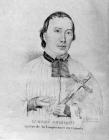 Credits:
Credits:The Archives de la Côte-du-Sud et du Collège de Sainte-Anne
Lithograph published by J.B. Rolland
03830
The Collection of the Musée régional de Kamouraska
16
Born on January 26, 1846, Charles-Alfred Roy, known as Desjardins, will be baptized two days later in the church of Saint-Louis-de-Kamouraska by the parish priest, Charles Chiniquy. This Catholic priest, an apostle of the Temperance movement, will leave the Catholic Church amid controversy in the last quarter of the 19th century to join the Presbyterian Church.17
A young sailor at the helm1900-1920
Unknown
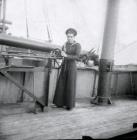 Credits:
Credits:The Collection of the Musée régional de Kamouraska
Photographer: Unknown
18
Like many other members of his family, it is not long before Charles-Alfred goes to sea. He is 13 when he is taken on as a sailor. In the following years, he travels extensively along the Saint Lawrence River and down the eastern coast of the United States as far as the Gulf of Mexico.19
Picnic at the lighthouse of the Îles PèlerinsAround 1900
Saint-André de Kamouraska (Québec), Canada
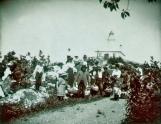 Credits:
Credits:The Collection of the Musée régional de Kamouraska
The Desjardins Family Private Collection
Photographer: Éva Roy, known as Desjardins
N.A.C. 2005.195
20
However, near the end of his teenage years, Charles-Alfred's life is marked by a tragic event. His father José, as well as his brothers Didier and Praxède, are drowned on October 6, 1863 while going to the lighthouse on the Îles Pèlerins where José is the lighthouse keeper.21
Taking a walk on the Îles Pèlerins1900-1920
Saint-André de Kamouraska (Québec), Canada
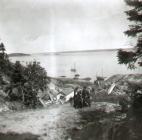 Credits:
Credits:The Collection of the Musée régional de Kamouraska
The Desjardins Family Private Collection
Photographer: Éva Roy, known as Desjardins
N.A.C. P2005.179
22
The drowning deaths of José and of two of his sons will not be the only hardship of this kind the Desjardins family will have to endure. Olivier Desjardins, a pilot on the Saint Lawrence, drowns in 1833 at the age of 24. In 1855, José's brother Joseph is washed overboard during a storm before the eyes of two of his sons, while they are sailing on the Grosse-Providence. Around 1870, Théophile, a cousin of Charles-Alfred will lose his oldest son and two of his daughters on their way for a visit in Charlevoix. Charles-Alfred's nephews, Arsène and David, will perish in the sinking of the Amélia in 1874. Finally, like the father of Charles-Alfred, his cousin Ignace, a lighthouse keeper, will lose his life in 1919 on his way to the lighthouse.23
A grain thresher or winnower1908-1914
Kamouraska (Québec), Canada
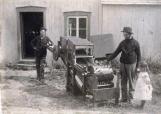 Credits:
Credits:The Collection of the Musée régional de Kamouraska
Photographer: Alex Buntin (Toronto Camera Club)
N.A.C. P1977.2909
24
The tragic loss of his father and two of his brothers marks the end of Charles-Alfred's seafaring life. He loves the sea but it does not have as much of an attraction for him as machines and their mechanisms. In 1863, he leaves the sea to return to the land and work in the clock factory of Antoine Rousseau. The factory is located in one of the sheds of the Campbell Manor. The following year, Antoine Rousseau develops a prototype of a grain thresher with an integrated windmill. However, his machine leaves too much dirt in the grain. Charles-Alfred finds the solution to the problem and invents a fan integrated into the thresher, which blows air to remove the dirt. This is the beginning of his success. Three machines are sold very quickly.25
A treadmill1908-1914
Kamouraska (Québec), Canada
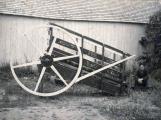 Credits:
Credits:The Collection of the Musée régional de Kamouraska
Photographer: Alex Buntin (Toronto Camera Club)
N.A.C. P1977.2908
26
To provide power for his thresher, Charles-Alfred tries to find a solution so that farmers will not have to rely on the wind. He feels it would be possible to use horses for this purpose and builds an inclined treadmill to be activated by one or two horses. Its tractive power becomes a source of energy that can be adapted to different machines: the crosscut saw, bench saw, sieve, grain mill, etc.27
In 1865, Antoine Rousseau abandons his business. Clocks with wooden mechanisms are no longer popular because people prefer those with metal mechanisms. Charles-Alfred buys Rousseau's company and begins the great adventure of working for himself and establishing his own business. His ingenuity and business flair will allow him to develop a flourishing enterprise whose reputation will extend far beyond regional borders.His factory is powered by a windmill and by an animal-driven wheel. A winter shop, a forge, a barn and a stable are also part of the site. The rapid success of this new entrepreneur is in keeping with the new momentum in the agricultural industry.